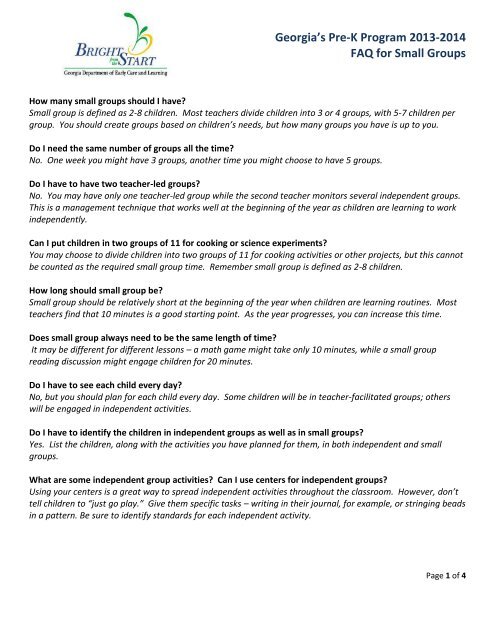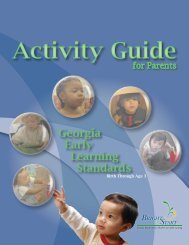Georgia's Pre-K Program FAQ for Small Groups
Georgia's Pre-K Program FAQ for Small Groups
Georgia's Pre-K Program FAQ for Small Groups
Create successful ePaper yourself
Turn your PDF publications into a flip-book with our unique Google optimized e-Paper software.
Georgia’s <strong>Pre</strong>-K <strong>Program</strong> 2013-2014<br />
<strong>FAQ</strong> <strong>for</strong> <strong>Small</strong> <strong>Groups</strong><br />
How many small groups should I have?<br />
<strong>Small</strong> group is defined as 2-8 children. Most teachers divide children into 3 or 4 groups, with 5-7 children per<br />
group. You should create groups based on children’s needs, but how many groups you have is up to you.<br />
Do I need the same number of groups all the time?<br />
No. One week you might have 3 groups, another time you might choose to have 5 groups.<br />
Do I have to have two teacher-led groups?<br />
No. You may have only one teacher-led group while the second teacher monitors several independent groups.<br />
This is a management technique that works well at the beginning of the year as children are learning to work<br />
independently.<br />
Can I put children in two groups of 11 <strong>for</strong> cooking or science experiments?<br />
You may choose to divide children into two groups of 11 <strong>for</strong> cooking activities or other projects, but this cannot<br />
be counted as the required small group time. Remember small group is defined as 2-8 children.<br />
How long should small group be?<br />
<strong>Small</strong> group should be relatively short at the beginning of the year when children are learning routines. Most<br />
teachers find that 10 minutes is a good starting point. As the year progresses, you can increase this time.<br />
Does small group always need to be the same length of time?<br />
It may be different <strong>for</strong> different lessons – a math game might take only 10 minutes, while a small group<br />
reading discussion might engage children <strong>for</strong> 20 minutes.<br />
Do I have to see each child every day?<br />
No, but you should plan <strong>for</strong> each child every day. Some children will be in teacher-facilitated groups; others<br />
will be engaged in independent activities.<br />
Do I have to identify the children in independent groups as well as in small groups?<br />
Yes. List the children, along with the activities you have planned <strong>for</strong> them, in both independent and small<br />
groups.<br />
What are some independent group activities? Can I use centers <strong>for</strong> independent groups?<br />
Using your centers is a great way to spread independent activities throughout the classroom. However, don’t<br />
tell children to “just go play.” Give them specific tasks – writing in their journal, <strong>for</strong> example, or stringing beads<br />
in a pattern. Be sure to identify standards <strong>for</strong> each independent activity.<br />
Page 1 of 4
How often do I need to change the children assigned to a small group? Can I keep the same children<br />
together <strong>for</strong> a week?<br />
<strong>Small</strong> group composition should change frequently. This doesn’t mean you have to change every day.<br />
However once or twice per semester is not often enough. If you are basing your groups on the needs and<br />
interests of the children then this will happen quite naturally. Many teachers find that changing each week<br />
works well <strong>for</strong> them.<br />
How do I decide who goes in each group?<br />
Base your groups primarily on assessment in<strong>for</strong>mation. You may also consider learning styles, children’s<br />
interests, and topics of study.<br />
What are different ways to group children?<br />
Homogeneously – all children in the group are on the same ability level. This allows you to focus your<br />
instruction on a specific skill or need.<br />
Heterogeneously – there are mixed ability levels within the same group. This promotes peer teaching and<br />
encourages group interaction.<br />
Both ways of grouping should be used in <strong>Pre</strong>-K, depending on the lesson objective and the needs of your<br />
children.<br />
Can I repeat the same lesson <strong>for</strong> multiple groups?<br />
There are some instances where you would repeat the same lesson <strong>for</strong> multiple groups of children – making a<br />
class book, <strong>for</strong> example. Other examples include a science experiment, a cooking activity or a follow-up to a<br />
field trip. Always ask yourself – do ALL children need the same experience?<br />
Please explain reading in small groups with a follow-up activity.<br />
At least once per week there should be a small group that involves reading to children and conducting a followup<br />
activity. This activity can be designed to encourage discussion and interaction. For example, you could<br />
have the students predict the outcome of the story, identify the main characters, or retell the story. You might<br />
choose to have children expand and practice concepts from the book such as, identify characteristics of insects,<br />
or play a counting game.<br />
Does every child have to participate in the weekly small group reading activity?<br />
No. You do not have to do this with every child during the week. However, many very effective teachers<br />
choose to do this multiple times during the week.<br />
What is scaffolding?<br />
Scaffolding is providing support to a child to move him to the next level of learning. It requires that teachers be<br />
aware of the small, discrete steps (continuum) involved in acquiring a particular skill and they know precisely<br />
where the child is on this continuum. Teachers can then model and provide feedback to guide children to the<br />
next level.<br />
How do I show that I am scaffolding?<br />
Assessment is key in planning lessons that scaffold learning. Basing lessons on assessment and grouping<br />
children accordingly will show you are aware of this important concept.<br />
Page 2 of 4
How much should I write in my lesson plan?<br />
Enough so that someone else (a substitute, your supervisor, the <strong>Pre</strong>-K consultant) can identify the purpose of<br />
your lesson, the materials you are using, the standard and the children who are involved. However, detailed,<br />
step-by-step directions are time consuming and not necessary.<br />
Example<br />
Copy, extend, create patterns brief description of lesson<br />
Ask children to “read” their patterns<br />
(friend photos, paper strips, glue sticks) materials<br />
CD-MA7.4a Standard<br />
AJ, BW, CR, KL, ST children assigned to group<br />
Can I put small group work in a child’s portfolio?<br />
Absolutely. There must be a variety of child-initiated and teacher-initiated work in the portfolios. A prime time<br />
to collect teacher-initiated work is during small group time.<br />
Can the same thing be in several children’s portfolios?<br />
Yes. Children that have participated in the same small group may have similar documentation. However, each<br />
child’s portfolio should be unique. There will be many items that are only in a single child's portfolio.<br />
What makes something a ditto or worksheet?<br />
A common characteristic of inappropriate dittos or worksheets is that there is a very narrow focus – only one<br />
right answer, <strong>for</strong> example. Typical examples of this kind of worksheet require children to circle or color or draw<br />
a line to indicate the correct answer.<br />
Another common factor is that the work is done entirely in the child’s head; it is abstract with no concrete<br />
manipulation of objects. <strong>Pre</strong>-K children still need hands-on activities. Appropriate paper and pencil<br />
representations should always be grounded in these concrete experiences. Appropriate examples include math<br />
graphs or science data sheets; these help children begin to abstractly represent a concrete experience.<br />
Does every small group have to result in a product?<br />
No. A small group may involve playing a game, <strong>for</strong> example, or a book discussion.<br />
Do I have to assess every small group activity?<br />
It is not necessary to assess every activity. Some lessons should be <strong>for</strong> introduction of a skill or <strong>for</strong> practice.<br />
Plan a few key assessments each week to make the process manageable. For example, one week you may<br />
decide to collect work samples from a science lesson, create a matrix <strong>for</strong> a math activity and take notes in the<br />
social studies domain during independent groups.<br />
Page 3 of 4
Page 4 of 4
















